This Stout Rye Pumpkin Sourdough artisan loaf, made with stout and sourdough, is not your average loaf made with beer. It’s a tasty and crusty loaf that isn’t sweet at all.
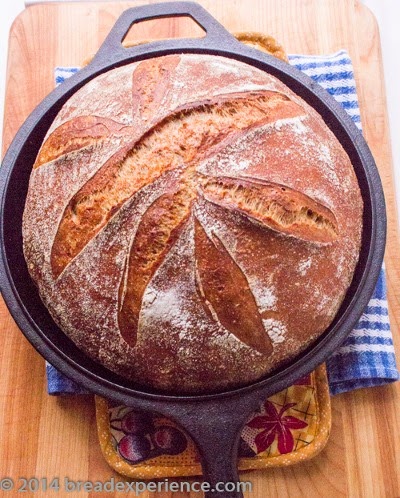
When you think of beer bread, if the image of a quick bread made with soda is what comes to mind, then I challenge you to get out of your comfort zone and try this bread. This Stout, Rye, and Pumpkin Sourdough is not your average loaf made with beer, and this is a good thing. I enjoyed this bread.
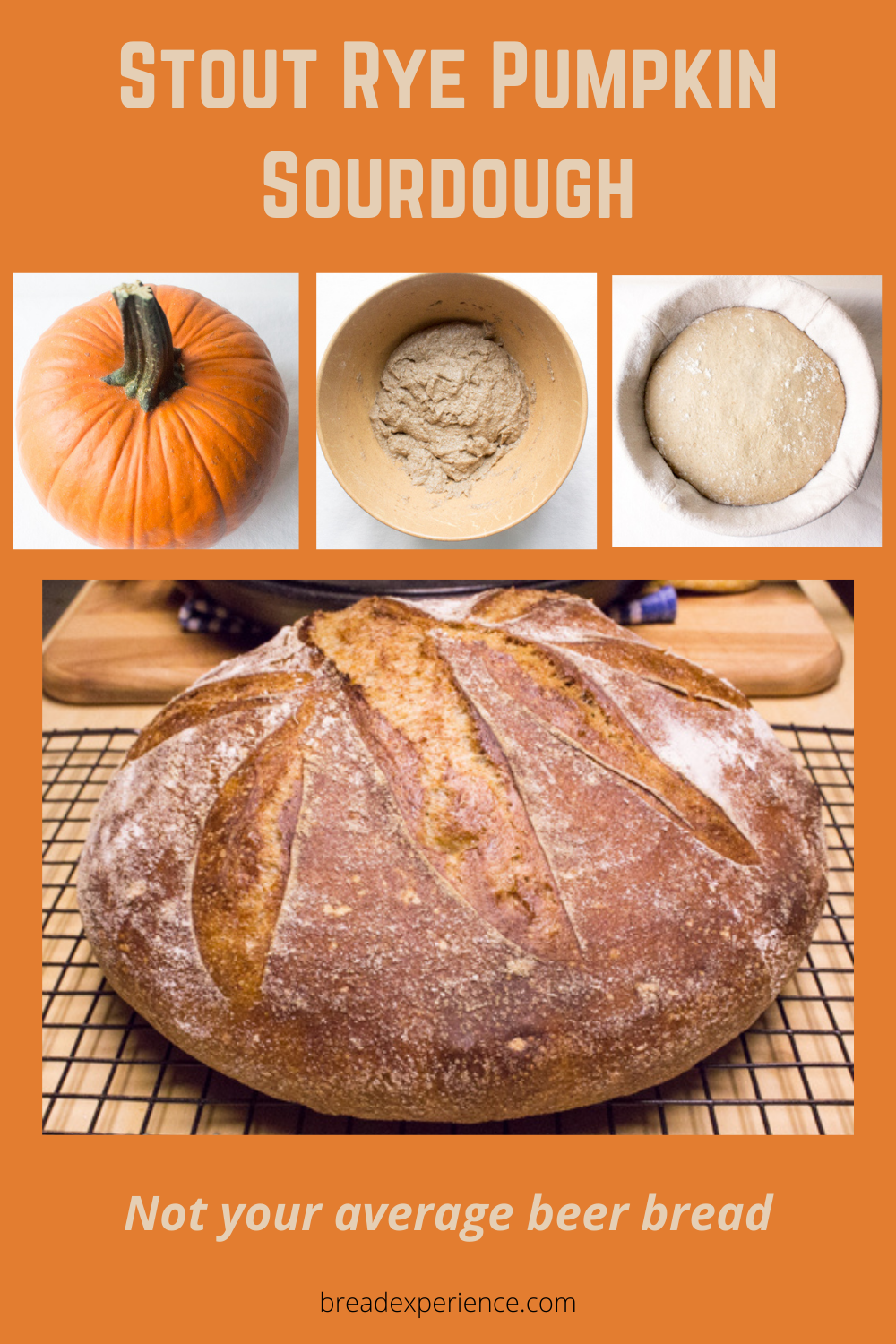
I’m not a huge fan of beer bread although I’ve made a few that I enjoyed, particularly ones that included rye flour. For the most part, the beer breads I tried before were too sweet and sort of empty of flavor. The taste and texture contradicted what my taste buds were expecting; however, not so with this bread. This artisan loaf is not sweet at all.
And to think, I almost didn’t make it. This was the bread of the month for December for the Artisan Bread Bakers FB group and my first thought was, “I think I’ll skip this one.” Then I started seeing photos popping up on FB of the beautiful breads the other bakers in the group had made and it looked like a bread worth trying. I’m so glad I decided to make it.
This bread reminds me of Ireland because it’s made with Stout. It’s an exceptional loaf.
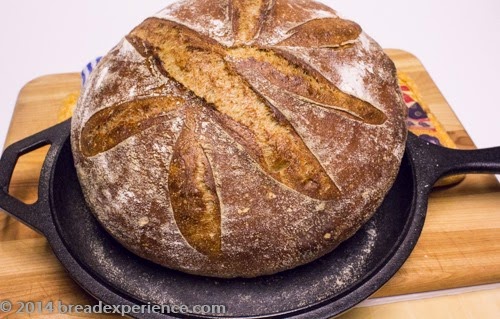
It takes a couple of days from start to finish to develop the flavor of this loaf. Don’t let that discourage you from trying it. Most of the time, the dough is fermenting. Good bread takes a while to develop the flavor. It is worth the wait so just plan according.
For instance, if you want to serve the bread for Sunday Dinner, start the levain Friday evening and let it rest overnight at room temperature. Make the final dough on Saturday, place it in the proofing basket, and let it cold ferment in the refrigerator overnight. Then take it out of the fridge on Sunday when you are ready to bake it.
Reflections on baking this Stout, Rye and Pumpkin Sourdough Bread in a cold Dutch Oven instead of a preheated Dutch Oven Combo Baker
Shared by Rod in Dallas (11/2/2017)
I wanted to give you my reflections on the Stout, Rye and Pumpkin Sourdough Bread.
First, I found the dough so slack that I only turned it once as it was so tender. So I let it ferment for several hours at room temp before putting it in the fridge . Then I retarded for the 24 hours. When I set up the bake, I turned the cold dough out onto a piece of parchment and popped it into a cold Dutch oven, slashed, covered and placed DO in the lower third of the oven. I turned the (cold) oven to 425°F and set timer for 30 mins. Then uncovered and baked for another 45 mins and voilà…
It was a no knead situation! I was thrilled…my third successful sourdough loaf! Tickled pink!
I had a couple of slices when I got home from Mass this afternoon and I’ve never tasted Sourdough bread so delicious (I don’t really like it or so I thought!) this is one tasty loaf! The Guinness makes it so “chocolaty”. I highly suggest using a cold Dutch Oven over an unwieldy super heated cast iron. Set the time as soon as you turn the oven on and remove the lid and bake uncovered for another 30-45 mins more. I’ve never encounter a sourdough crumb like this one! It’s just spectacular!
Pax et Bonum,
Rod Ferris
Stout Rye Pumpkin Sourdough
(Makes 1 loaf)
The oven spring on this loaf is phenomenal. It just pops during the bake cycle. The crust and crumb are exceptional as well. I baked it in a Dutch Oven Combo Baker, but you can use any type of Dutch oven to bake this loaf.
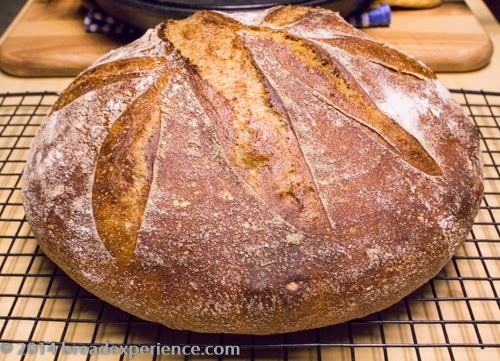
Directions:
Day 1 (Morning): Feed sourdough starter
The morning of the day before you plan to make this loaf, feed your sourdough starter so that it is active and ready to go.
Day 1 (Evening): Prepare the levain
Prepare your levain the evening before you plan to make the dough.
- 45g starter (100% hydration)
- 150g Stout beer – room temperature
- 150g Rye flour
Place the sourdough starter in a medium bowl and pour the stout over it. Stir to break up the starter. Add in the rye flour and mix the ingredients until the flour is completely hydrated. Cover the bowl with plastic wrap, and let it ferment at room temperature overnight (8-12 hours, depending on your starter). The mixture will not double but become fluffy and airy. I let mine rest for the full 12 hours.
Day 2: Prepare the Final Dough
- All of the levain
- 165g Stout
- 165g warm water
- 50g pumpkin puree
- 500g Bread flour
- 10g sea salt
Combine the levain with the stout, water, and pumpkin. Add the flour and mix until it is incorporated into a shaggy mass.
Cover the dough and let it autolyse (rest) for 30 – 60 min. Allowing the dough to rest before adding the salt, helps the gluten begin to develop and keeps the dough from getting tough.
After the autolyse, add the salt, and mix until fully incorporated. Add a few drops of water to help dissolve the salt, if necessary. Mix the dough for a few minutes on low/med speed on the mixer, or use the fold-and-turn method in the bowl if you are doing this by hand.
Turn the dough out into a greased bowl. Perform a series of folds, then cover tightly with plastic wrap. Repeat stretch/folds every 30 min for the first two hours. After the first two hours, bulk ferment on the counter for an additional 1 -2 hours.
Turn the dough out onto the counter or wooden board, cover, and bench rest for 10 min. Prepare a round banneton or linen-lined basket or bowl by dusting it with brown or white rice flour. Shape dough into boule, and place in the banneton.
If you place the dough seam side down, when it is turned out into the Dutch oven, the seam should open up naturally in the oven without having to slash the dough. If you prefer to score the dough before baking, place the boule seam side up in the basket.
Place dough in a plastic bag and cold ferment in the fridge (12 – 24 hours).
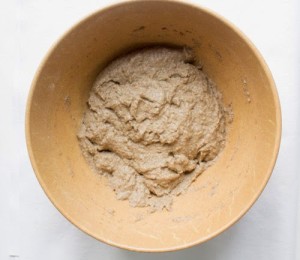 |
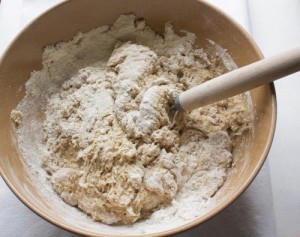 |
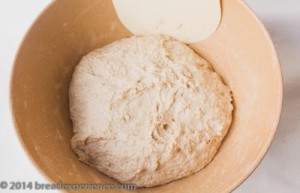 |
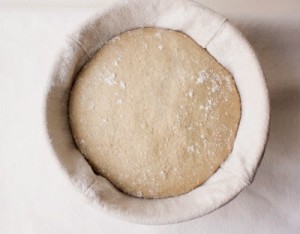 |
Day 3: Bake the Loaf
Preheat the oven to 500F (260C) for at least 40 minutes with a cast iron Dutch Oven on the middle rack. You’ll bake the dough directly from the fridge so don’t remove the proofing basket until you are ready to flip the loaf into the pot.
Carefully turn the dough out into a combo cooker or Dutch oven, slash (if your seam is down), cover, and put in the oven.
I decided to try it with the seam side down in the basket; however, when I turned it over into the combo baker, the seam was mostly gone so I ended up scoring it anyway.
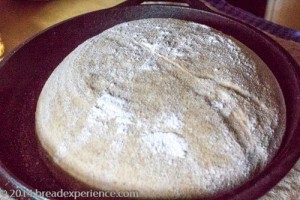 |
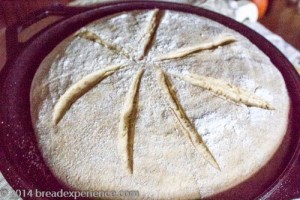 |
Reduce temperature to 475F (245C) and bake covered for 25 minutes. After 25 minutes, carefully remove the lid, reduce oven temp to 450F (232C), and continue baking for an additional 25 minutes, or until the crust turns a dark chestnut brown. Don’t be afraid to bake strong for a dark flavorful crust.
Cool on a wire rack for 90 minutes before slicing.
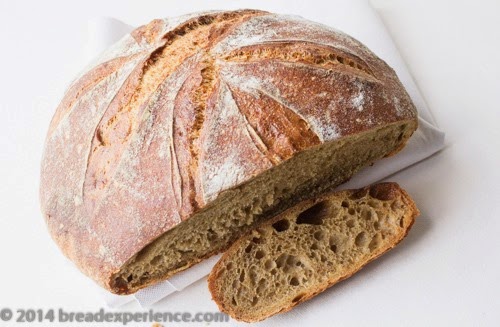
I’m sending this Stout, Rye & Pumpkin Sourdough to be yeastspotted.
I had fun with this one. I decided to make a collage of the ingredients and post it on FB to see if anyone could figure out what I was making. Fortunately, someone was watching and guessed it. Thank you.
Happy Baking!
Cathy
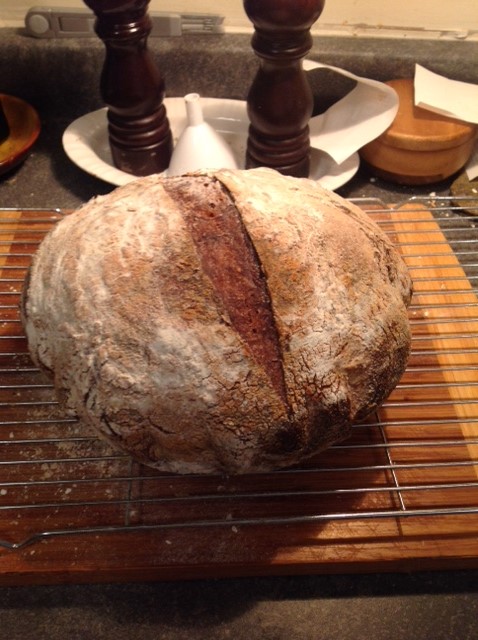
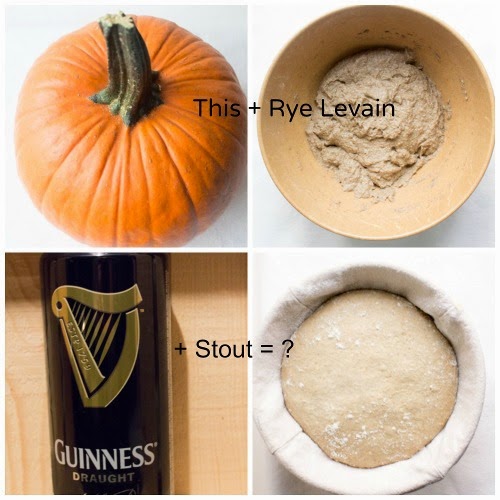
Karen Kerr says
Looks wonderful Cathy!! Love the collage =)
Lauren says
Wonderful flavor! I used milk stout and mashed sweet potatoes (my CSA loves to give us sweet potatoes…), and think I probably used some whole wheat for the bread flour. My crumb is pretty tight (see link below to instagram picture) and I suspect that’s user error – I still don’t time the bulk fermentation well and have trouble shaping. I’m wondering about throwing some cornmeal in and trying to make into rolls for Thanksgiving. Thanks so much for this recipe!
https://www.instagram.com/p/BbeR7y5lmnk/?taken-by=inthewildlight
Cathy says
Hi Lauren,
Thank you for posting about your experience with this bread. Your loaves look great! Perhaps the tighter, moister crumb is also from the milk. That’s not a bad thing. I think you could use your version as rolls as is but the addition of cornmeal sounds good as well. Let me know if you decide to try it.
I made a sweet potato version of this loaf earlier this year that turned out really well. https://www.breadexperience.com/sweet-potato-einkorn-sourdough-stout-bread/
Happy Baking!
Cathy
Lauren says
Cathy, thanks so much for your reply. I didn’t even think about the lactose in the milk stout contributing to the tighter crumb – that probably had something to do with it. Your einkorn sweet potato version is so lovely, I’m going to continue playing with this recipe – thanks again!
Nanci says
Such a beautiful loaf! I actually used a winter ale & it turned out just right. Can’t wait to try it with stout!
Cathy says
I’m glad your winter ale turned out so well. I think any type of ale would work in this bread, but the stout does work particularly well with the pumpkin.
Maria says
I am looking forward to making this. In step #1 is active starter or unfed starter used?
Cathy says
Hi Maria,
I think you could use active (just fed) or unfed starter from the refrigerator as long as its been fed within the past week or so. Otherwise, it will be too acidic.
I hope you enjoy it. Let me know how it goes.
Happy Baking!
Cathy
Terri Cole says
Just took this out of the oven. Can’t wait to taste it!
https://www.instagram.com/p/CLw98zljYj0/?igshid=75cl3yjgbewy
Cathy says
It looks wonderful! I hope you enjoy it!
Patricia Swanson says
Hello Cathy. I had one last bottle of Guinness Stout left from other bread recipes, so decided to try this one. I have been baking sourdough bread for just five months now, but I have had wonderful success with my starter, named Audrey III. Audrey II was from Little Shop of Horrors. Feed me, feed me! This dough was not my favorite of all I have tried. It was SO wet. I probably lost 4 ounces of dough to my fingers between stretch and folds. I was so glad to get it into the refrigerator last evening where it stayed for 16 hours. I took the advice of others and started it in a cold Dutch oven on parchment paper. I did start it at 450F for 30 minutes. When I removed the lid, I turned down the temp to 425F for 25 more minutes. The temperature reached 200F in the loaf, so I took it out. Later tonight, I will give it a taste!!
Cathy says
Hi Patricia,
Thank you for sharing your experience with this bread. High hydration dough can be a bit tricky to work with. If you use wet fingers, it helps.
Did you get good oven spring by starting with a cold DO? I’ve had mixed results with that method although I haven’t tried it with my new oven. I’m always curious about the results other bakers using different baking methods.
Patricia Swanson says
I would say that I got a good oven spring. I had great rise in the frig over the 16 hours. The crumb had lots of small bubbles, but no big ones. I am just now eating it. Excellent flavor, good chew on the crust, and very tender inside.The aroma is a bit sweet, but I cannot identify either the pumpkin or the Stout. I will be eager for my husband to return from skiing tomorrow and taste it. I am certainly glad that I tried this recipe. I went to get more Guinness Stout today, and there was a good deal on a 24 pack at Costco. I guess I better get busy! Thanks for this great recipe.
Cathy says
Very cool! I’m glad you enjoyed this bread. Sounds like more baking is on the horizon! Happy Baking!
Sharon Coltrane says
Cathy,
I love your bread recipe. I haven’t bought a loaf of bread in over three years. I usually bake sourdough bread so when I saw your recipe I had to try it. The only change was using regular flour and not bread flour. It turned out really well. We had a hard time waiting for the bread to cool. I love the taste. Thanks so much for sharing.
Cathy says
Sharon, thank you for sharing your thoughts on this Stout Rye Pumpkin Sourdough. I’m so glad you enjoyed it.
These days, I typically use all-purpose flour rather than bread flour myself, especially if it has a higher protein like KAF all-purpose.
I know what you mean about waiting for the bread to cool. I have a hard time with that one myself.